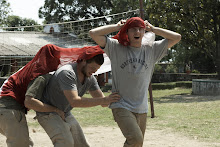
It was difficult to come here because they burned our village,” recalled Ismail Ahmat Ishach, a father of six.
“We had to flee immediately, our families were scattered and we had nothing to bring but what we wore that night,” he said, referring to the Janjaweed.
“It took us over three days to get here and we had donkeys,” said Mr Ishach, who added that he and his family were lucky to have make it here alive.

Tens of thousands of refugees from Darfur and the Central African Republic languish in refugee camps in Chad, making it one of the 10 countries hosting the most refugees.
Many thousands of local people have also been forced from their homes.
Koukou is just 35 miles from the poorly defined border with Darfur.
It barely existed until an attack by Janjaweed militias on border villages in April 2007.

Khakeidja Hamat arrived with her two children a few weeks ago. She said she is "happy to be out of danger, even though we’ve left everything and don’t have much here."
Mrs Hamat and the other displaced people in Koukou are from the Massalit communtiy, one of the main groups targeted by the Janjaweed both in Darfur and Chad.
They account for nearly half the Sudanese refugee population now in Chad.
Now ask....What can I do about this? Can I do anything about this?
Photo's and photo commentary by BBC.

No comments:
Post a Comment